Unity Audio ‘Inner Soul’ Speakers Revisited and a Mini Interview with Omer Humayun
MSRP: $900 Canadian.
Review by David Neice
Verdict: The main strength of the Unity Inner Soul V3, a stand mount single driver speaker, is resolution. Initially they come on as bracing and a bit in your face, but with time they also seem refreshingly direct and encourage the listener to plumb the depths of any recording.
The laws of physics declare that a four inch or so single driver is going to have some problems with deep bass, but the mid-bass is so fetching that the listener is lulled into thinking that little is missing. Nonetheless, I used a small REL subwoofer with the Inner Souls to round out the bottom end, and I suggest that many users would benefit from such an application.
An unusual design for an all-Canadian speaker, the Inner Souls are firmly recommended, particularly as their high efficiency encourages the use of low powered tube amplifiers. They are also very good value, are marketed directly to the end user, and offer a ten year limited warranty and, by all accounts, Unity Audio also offers excellent user/owner support.
Opening
It has been eight years since Wall Of Sound first looked at the Unity Audio Inner Soul, and this popular single driver speaker has since gone through two updates. We thought a revisit was in order and have combined this equipment review with portions of a short interview we did with the speaker’s designer Omer Humayun.
The Unity Audio line of single driver speakers encompasses four models of differing sizes and configurations (Footnote 1). The designs include the Inner Soul standmounts, the Inner Soul Towers (which Colin reviewed here in 2017), the Whitewater standmounts, and the Whitewater Towers. The two basic models are distinguished by the smaller four-inch driver of the Inner Souls and the larger five-inch driver found in the Whitewaters. Further details on distinctions between the models can be found at Unity Audio’s website, here.
I had reached out to Omer to ask for a loaner pair of Whitewaters for review and then during our correspondence, I discovered that a fairly new pair of Inner Soul V3’s were up for sale on Canuck Audio Mart, so I bought them. I have always been ‘single driver curious’ and I wanted to scratch that itch. So yes, I do own the pair we have under review.
Description
The Inner Soul V3 standmounts are a small compact reflex design with a rear port. The driver is made by Airborne and tweaked to a specification supplied by Unity Audio. The driver has a rubber surround and the cone is made of composite wood fibre, with the attached whizzer cone made of the same material.
My pair are beautifully veneered in walnut with a trace of red in it, so it looks very much like rosewood. Finishes include several veneers or satin lacquers. Omer admits that in the early days of his production he had some problems with vinyl wrap and so he has abandoned its use and now has a skilled wood worker apply the veneer.
Solid binding posts are fitted to the back above the port, although the spacing might be a bit tight if you use heavy spade connectors. I use banana plugs so there was no issue.
Unity Audio has developed a somewhat casual approach to technical specifications, and this befits a small batch production company. For instance, frequency response is referred to as ‘within the range of human hearing, down to the high 40’s’. Recommended power is stated as 5+ watts. Sensitivity is indicated as ‘in the low 90s’, and impedance is eight ohms. No firm empirical markers for these broad statements is offered, but most listeners are unlikely to care.
The Inner Souls are diminutive, being 7″ Wide (front) X 10″Deep X 12″ High. They weigh 21 pounds per pair, are quite solid and have a lovely finish.
Readers may ask what changes account for the various versions from V1 to V3? I inquired about this to Omer and here is the answer.
“The transition from V1 to V2 had a slight change in dimension to make it more desktop friendly, and also indicated a transition to a different cabinet maker. This new cabinet maker was able to do really nice veneers on request.
The current V3 version saw further tweaks in dimensions to better fit most standard speaker stand top plates, as desktop use wasn’t something that the target market seemed to be interested in. Plus, a wider front baffle was needed to accommodate the thicker section of the baffle that the driver mounts to. Added as well, are adjustments/tweaks to internal damping materials.
Veneer or enamel are the only options now. Vinyl is no longer an option. The V3 also denotes the use of a new cabinet maker – not only better quality work, but he’s able to make them in batches. I will be using him for the foreseeable future, as he’s easy to work with, and is local, reinforcing the aim of offering a product made in Canada’s capital.”
Interview with Omer H.
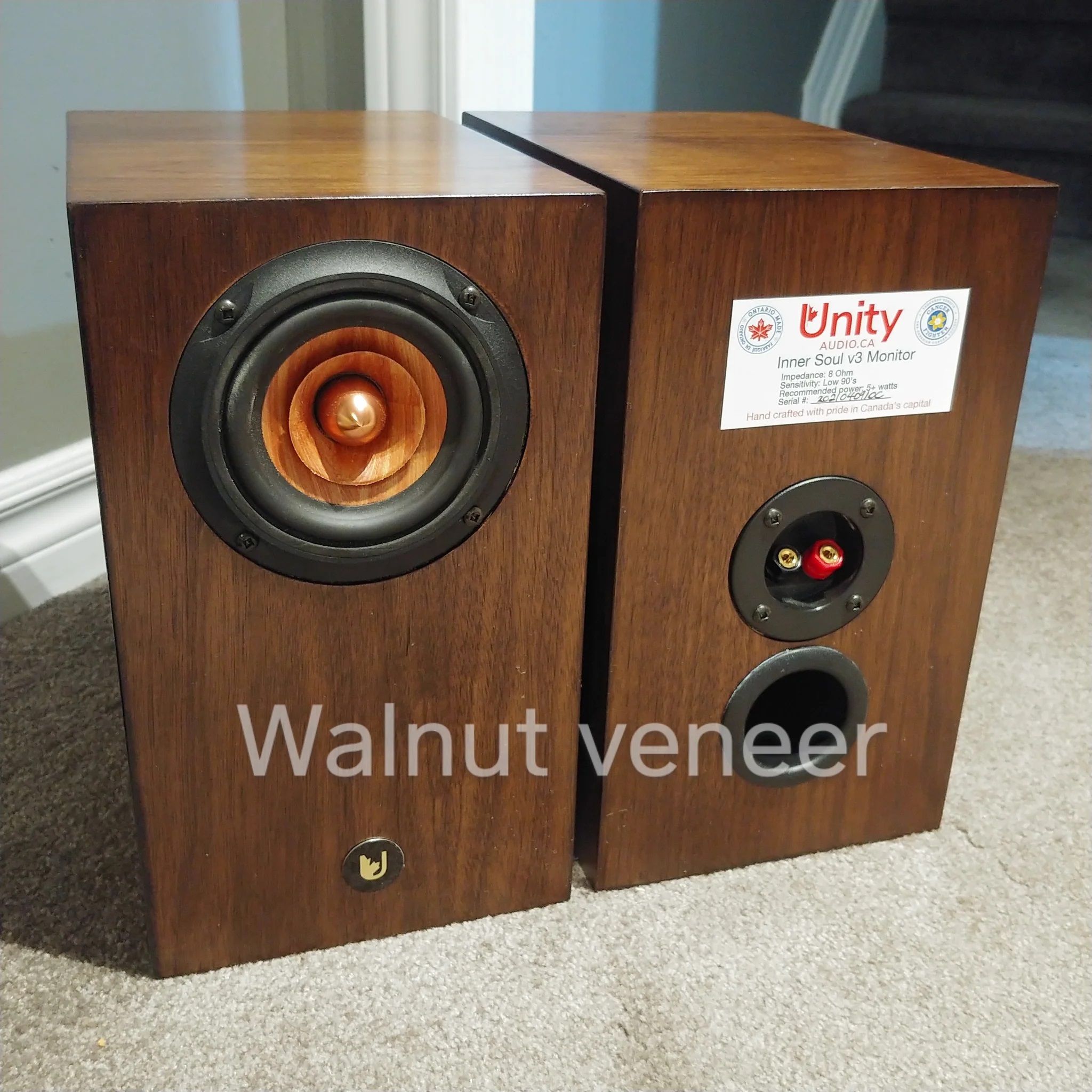
During the review period I reached out to Omer with other questions and decided to use his detailed answers as part of this review. So, we now have a kind of mini-interview as well as a review.
David: When you first started making speakers, why did you choose to go down the single driver road?
Omer: The thoughts that went through my mind at the time were ‘the world doesn’t need another 2-way speaker’, as well as ‘let’s make something that works well with low-powered tube amplifiers’.
I was a dealer for Jolida at the time, and my favorite was the 102b amplifier, which used the EL84 tube in a push-pull configuration. I had heard full range drivers in the past, and they always had magical microdynamics that couldn’t be reproduced in multi-way designs. They had a certain magic in the midrange.
Fostex made a great driver that wasn’t too expensive, so we started with that, and built a double bass reflex cabinet around it. The design was suggested by Fostex, but it was changed and tweaked to perform better to my ears. It was shown at the Montreal Audio Show in 2005, with Cary amps (I was also a Cary dealer at the time).
David: When did you settle on the Airborne drivers for your single driver designs?
Omer: For as long as I can remember, I’ve always wanted to try different things. The uniqueness of the Airborne drivers piqued my interest, and the parameters of the driver were very similar to the Fostex driver already in use in the ‘Spirit’, and ‘Inner Spirit’ speakers. So, I ordered a set, dropped it into the test box, and listened.
What I heard was surprisingly good. It had an organic quality that didn’t show up on test equipment, but the goosebumps were undeniable. And build quality was more robust – cast frames, and rubber surrounds. I’ve since had the drivers modified to perform a bit better than stock. Plus I don’t know of anyone else making an affordable product that uses a full-range wood fibre driver.
David: How did you devise the two current models; the ‘Inner Souls’ and the ‘Whitewater’?
Omer: The aim of all the models is to excel in smaller spaces. The current models are an evolution of the original offerings of the ‘Inner Spirit’, ‘Whitewater’, and ‘Clearwater’.
When the ‘Inner Soul’ was added to the lineup, the ‘Inner Spirit’ was still being offered, so the name couldn’t be re-used. The ‘Whitewater’ V2 was originally going to be called ‘Soul’, but another speaker company was already using that name for one of their models.
There’s a third model called the ‘Richmond’ which uses a (different) six-inch full range wood coned driver. A V2 of that model is in the works, with driver design and manufacturing done here in Canada.
The driver offered from Airborne was good, but this one promises to be better. And, the name refers to a small town south of Ottawa. Names of future models will be taken from towns in and around the Nation’s capital, reinforcing that everything is made here.
David: Making esoteric speakers for a small market in Canada must be tough. Are you able to grow the company?
Omer: It certainly is a challenge – the biggest one is getting people to listen to them, and get past the idea that you need more than one driver to do everything. In time, after more published reviews, customer testimonials, and exposure at audio shows and in dealer showrooms, growth is inevitable. Many of us are downsizing to smaller spaces, and I feel this product addresses the changes in everyone’s lifestyle, without sacrificing the enjoyment brought from good audio reproduction.
Thank you Omer for these insightful comments.
The Sound
I listened to my pair of Unity Audio Inner Soul V3’s on and off for about a month. I placed them on 30 inch stands about seven feet apart and 20 inches out from the (long) back wall.
The accompanying gear is simple; a Naim Nait XS amplifier, a pair of Audio Sensibility Impact speaker cables and a Cambridge Audio 640C CD player. Vinyl is played via a Gold Note Valore Plus turntable with an all-acrylic body and platter with the arm fitted with a HANA EL cartridge.
Initially the Inner Souls dazzle you with a very fast, forward and somewhat in your face sound field. Their main strength is resolution and microdynamics and this is where they excel, so vocals are quite well-rendered. After a bit of time you come to expect this level of resolution from other speakers, which you may then find missing.
The initial forward emphasis also wears off and the listener starts to ‘fall into the sound stage’, looking for previously hidden details. The effect is quite natural and pleasant. I found that I was listening at much higher db levels than usual because of the enhanced clarity of the Inner Souls.
There is not much lower bass though, at least with this model as compared to the Towers, and I think they really do need a sub to complete the picture (Footnote 2). I have a REL T/Zero Mk iii to fill out the bottom end. The REL is tiny and looks like a toy but it is lightning fast and is a ‘sub for people who hate subs’. In other words, no thundering Jurassic Park home theatre sonics are found here.0
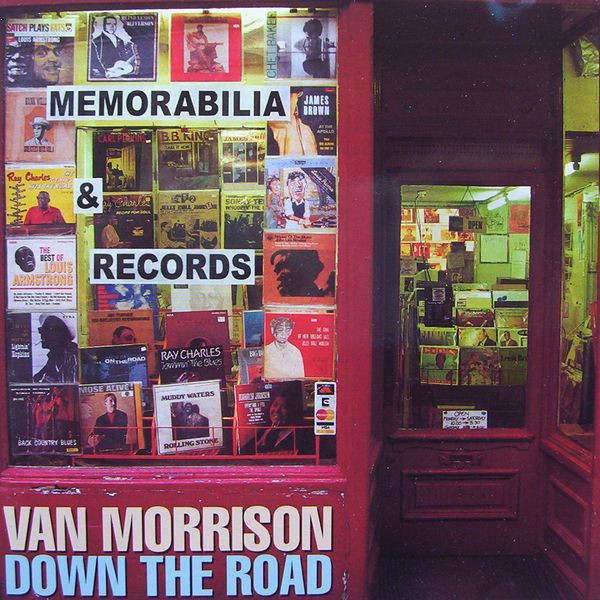 I will share a few of my notes from several listening sessions. Selecting Van Morrison’s ‘Down the Road’ album I chose the tracks Chopping Wood and No Work and No Play. These are dense tracks with overlapping saxophone solos. I was quite surprised at the ability of the Inner Souls to track the complexity of the music, and Van’s voice was well resolved throughout these performances.
I will share a few of my notes from several listening sessions. Selecting Van Morrison’s ‘Down the Road’ album I chose the tracks Chopping Wood and No Work and No Play. These are dense tracks with overlapping saxophone solos. I was quite surprised at the ability of the Inner Souls to track the complexity of the music, and Van’s voice was well resolved throughout these performances.
I played Katie Melua’s album ‘Pictures’, and focused on the track My Secret Life. Melua’s gentle soprano voice was shiningly resolved, with great inflection and a sweet rendering. In complete contrast, the opener to Dire Straits album ‘On Every Street’ titled Calling Elvis was a thumping romp, with Knopfler’s guitar flourishes and voicing having center stage.
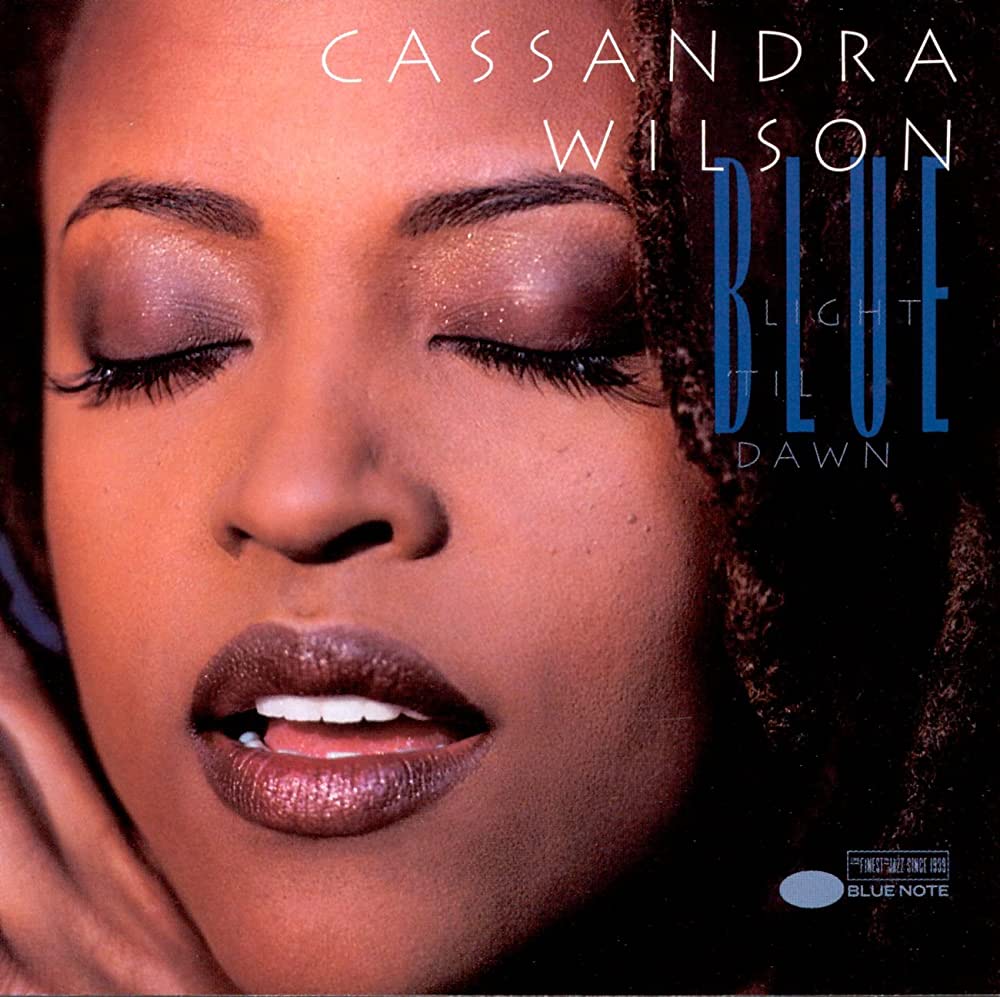 This was followed by Cassandra Wilson’s tour de force album ‘Blue Light Till Dawn’. Wilson reworks two Robert Johnson classics, Come On Into My Kitchen and Hellhounds On My Trail. These are extraordinary tracks and are completely unlike the originals. The Inner Souls did a great job of rendering these top drawer performances with all the flourishes of various instruments attracting my intense attention along with Wilson’s gorgeous contralto voice.
This was followed by Cassandra Wilson’s tour de force album ‘Blue Light Till Dawn’. Wilson reworks two Robert Johnson classics, Come On Into My Kitchen and Hellhounds On My Trail. These are extraordinary tracks and are completely unlike the originals. The Inner Souls did a great job of rendering these top drawer performances with all the flourishes of various instruments attracting my intense attention along with Wilson’s gorgeous contralto voice.
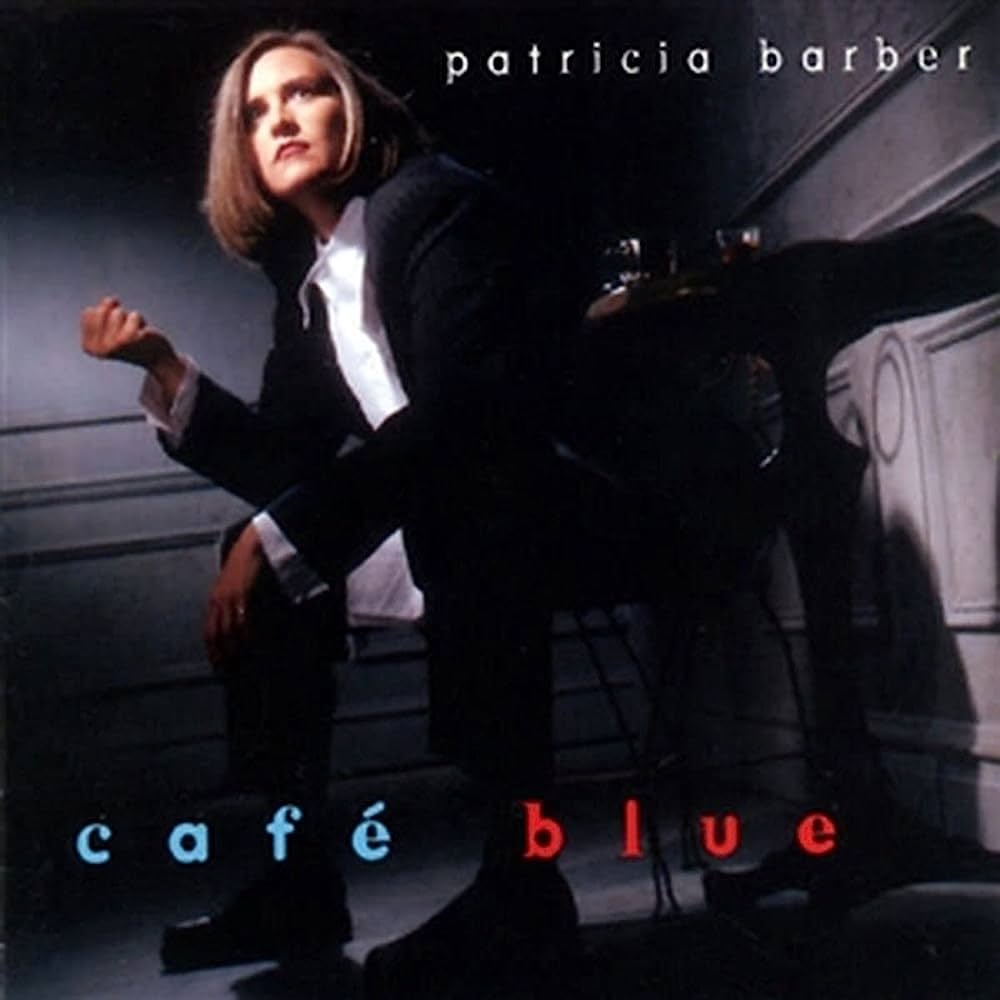 Speaking of audiophile CDs, I played all of Patricia Barber’s great album ‘Cafe Blue’, one of the select audiophile recordings I own. In particular the tracks Ode to Billy Joe and Too Rich for My Blood were compellingly rendered. I have heard these tracks many times, and Barber’s voice was completely unstrained as she rises in a soprano crescendo up to the very limits of her vocal cords. This was, in my view, a fantastic performance by the Inner Souls.
Speaking of audiophile CDs, I played all of Patricia Barber’s great album ‘Cafe Blue’, one of the select audiophile recordings I own. In particular the tracks Ode to Billy Joe and Too Rich for My Blood were compellingly rendered. I have heard these tracks many times, and Barber’s voice was completely unstrained as she rises in a soprano crescendo up to the very limits of her vocal cords. This was, in my view, a fantastic performance by the Inner Souls.
Finally I played all of Jenn Grant’s CD ‘Paradise’. This is a particulaly dense CD by Grant, and her voice tends to get buried in the mix, unlike her other albums. I was pleasantly surprised to see the Inner Souls working hard to unpack the mix, and I found their exceptional clarity to be refreshing with this CD, a favourite of mine despite the loss of detail in her vocal presentation.
This is just a brief sampling of what were dozens and dozens of CDs I played over a period of about six weeks. The Inner Souls would always reach out and encourage me to switch them on and then explore my music library. This is the sure sign of a competent speaker system.
Comparisons
The other night I swapped in my DALI Spektor 1’s for the Inner Souls. This is hardly a fair comparison as the DALIs retail for $399, but I am very fond of them and find their sonic signature to be in a completely different class from their modest cost. They are tiny speakers and really must be supported by a subwoofer, so the REL was duly tasked.
The Inner Souls offer a mesmerizing organic sound that is tonally quite accurate. However, I still find there is a tonal rightness to the littlest DALIs that is very attractive and relaxing. The sound stage is more modest and yet still holographic. The integration with the REL subwoofer is smooth and the whole thing is very convincing with the Naim Nait XS driving them. But, as always, this is my humble opinion.
However, the Inner Souls are no slouch and what they do well, which is midrange magic and exceptional resolution, are simply impossible for the little DALIs to match. With the Inner Souls, the sense of the total soundstage is larger, and the depth perspective is enhanced, as is their image specificity. Long hours can be tracked by the listener using the Inner Souls, where the sonics of the recording studio and microphone placement are revealed. These are the much sought after characteristics of multi-thousand dollar monitor speakers and not speakers that retail for under $1000.
User Comment
In an unusual move I reached out to a long-time user of the Inner Souls, Gilles Levesque of Ottawa. He offers this concise resume of the Inner Souls attributes.
“An easy to match small speaker with a focused and exceptionally accurate sound….it delivers a very acceptable amount of low frequencies, but certainly will benefit from a well-integrated sub. In a small room with the appropriate music and the right amplification, you may even be able to get away without a subwoofer.
The Inner Souls may be just as revealing but have a snappiness my Harbeth’s (30.1) just didn’t have. The wooden full range driver has a lot to do with that. I have forgotten a few times to turn on my sub and the resulting sound was still very acceptable. Since having them, I drove them with a 35wpc tube amp, a 200wpc class D, a Naim SuperNait 3 and the Heed Elixir. All were a wonderful match, displaying different attributes, but they seem to excel and become magical with tube amplification.
I currently have them connected to a Krell KVA-250a using the HEED Elixir as a pre-amp. They are accompanied by a pair of REL T5x subwoofers and the results remain very well balanced as well as stunning! The increase in power seems to have added a transparency to the sound that makes the instruments float on air, a very pleasing and almost like being there sound.”
Conclusion
On balance the Inner Souls can be firmly recommended, and they are even more firmly recommended for customers with low output tube amplifiers such as SET designs.
The only caveat I have is that for some users, and for some types of musical preferences, the use of a subwoofer will be a significant consideration for this particular stand mount model. However, there are other options. Both the Inner Souls and the Whitewaters are offered in Tower versions that extend the bass another half octave or so. For some customers this could be the right answer. Bravo!
Footnotes
(1) Unity also offers a more conventional two way design, the Warrior.
(2) This may be debatable. It all depends on the listener and the source material they prefer. I like rhythm and blues and this needs a strong bass foundation to drive the music, but if I liked chamber music a sub would likely not be needed. Mileage here will vary. At any rate the Tower versions of these speakers go deeper.


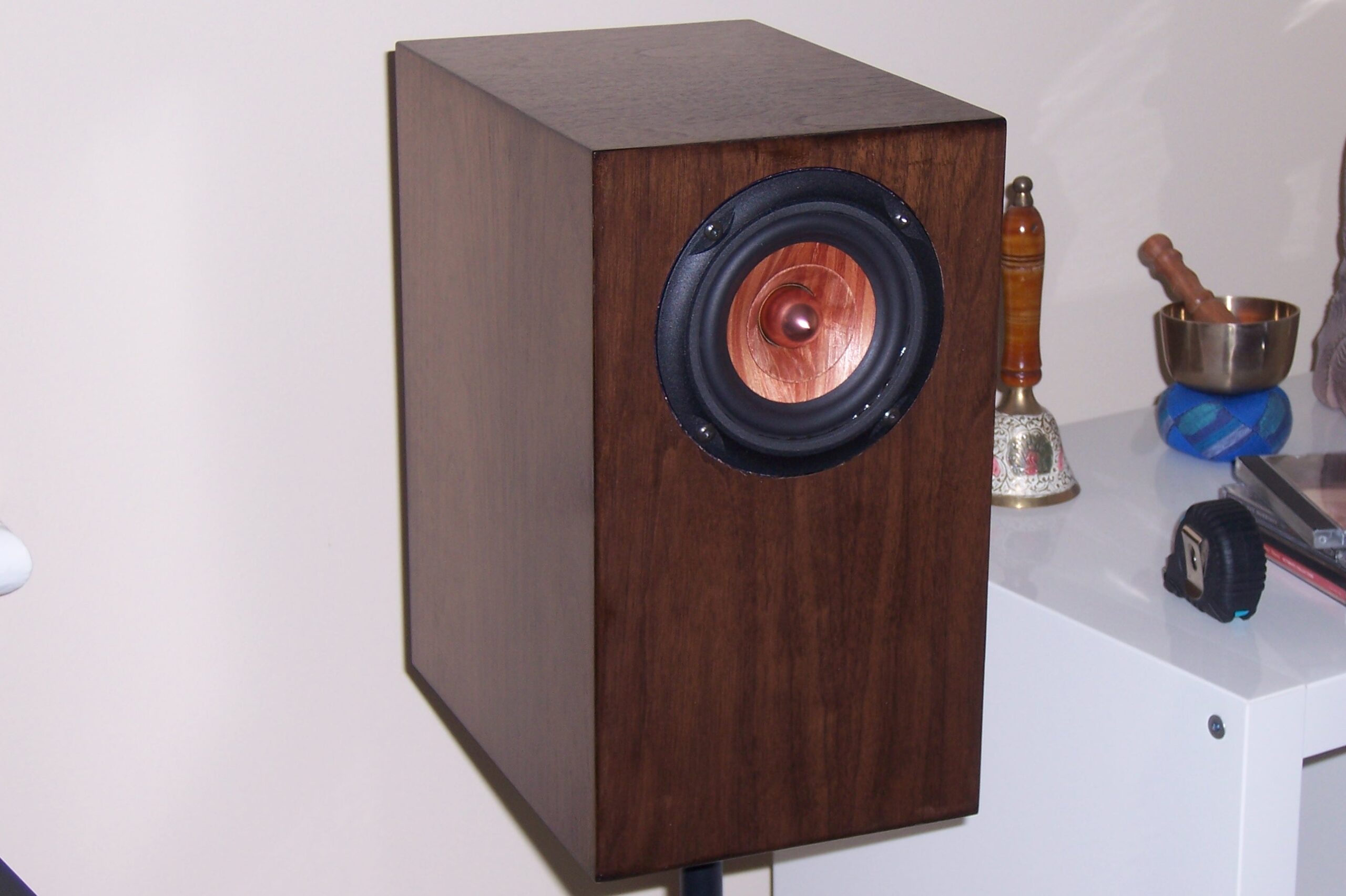
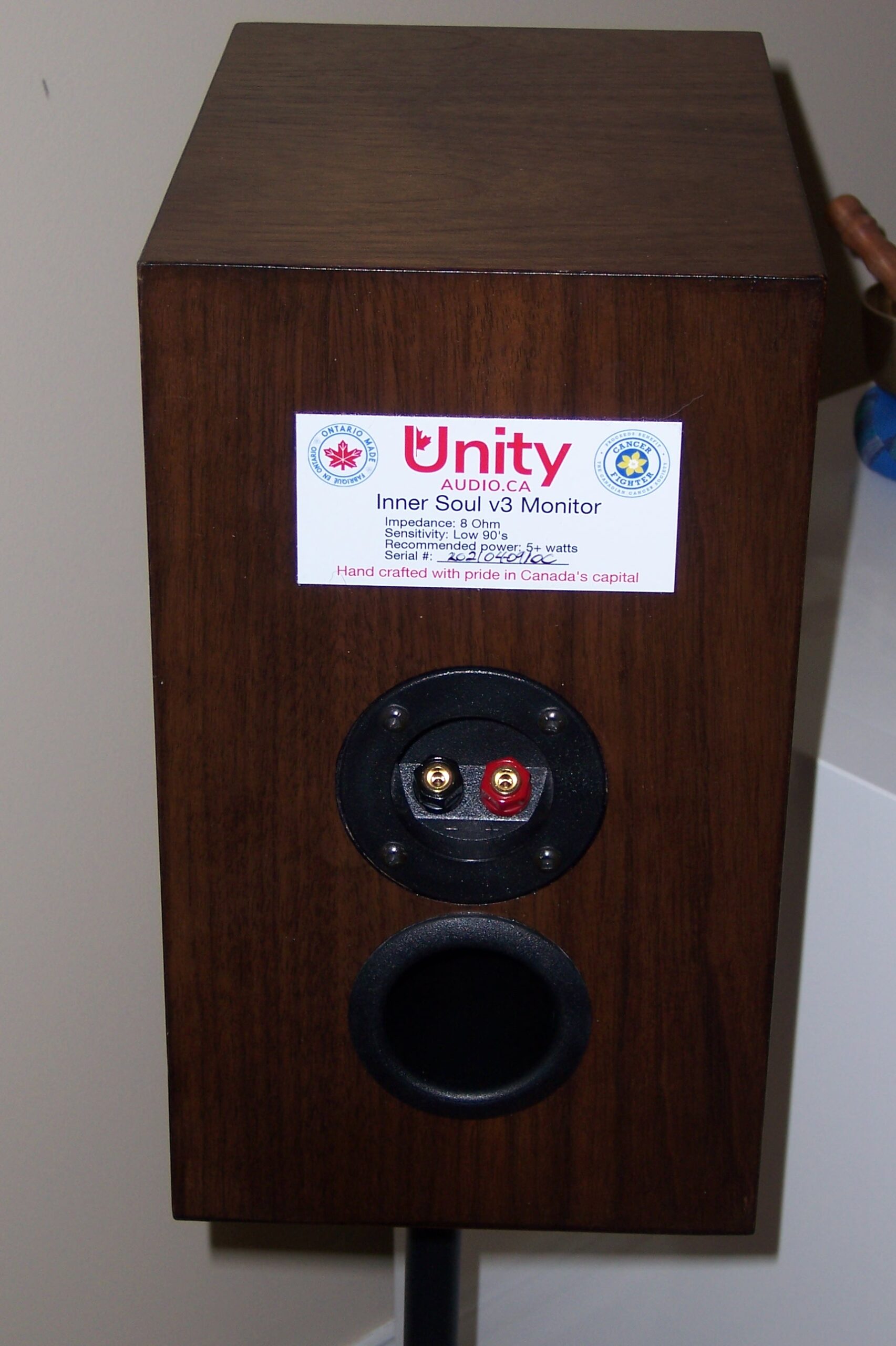
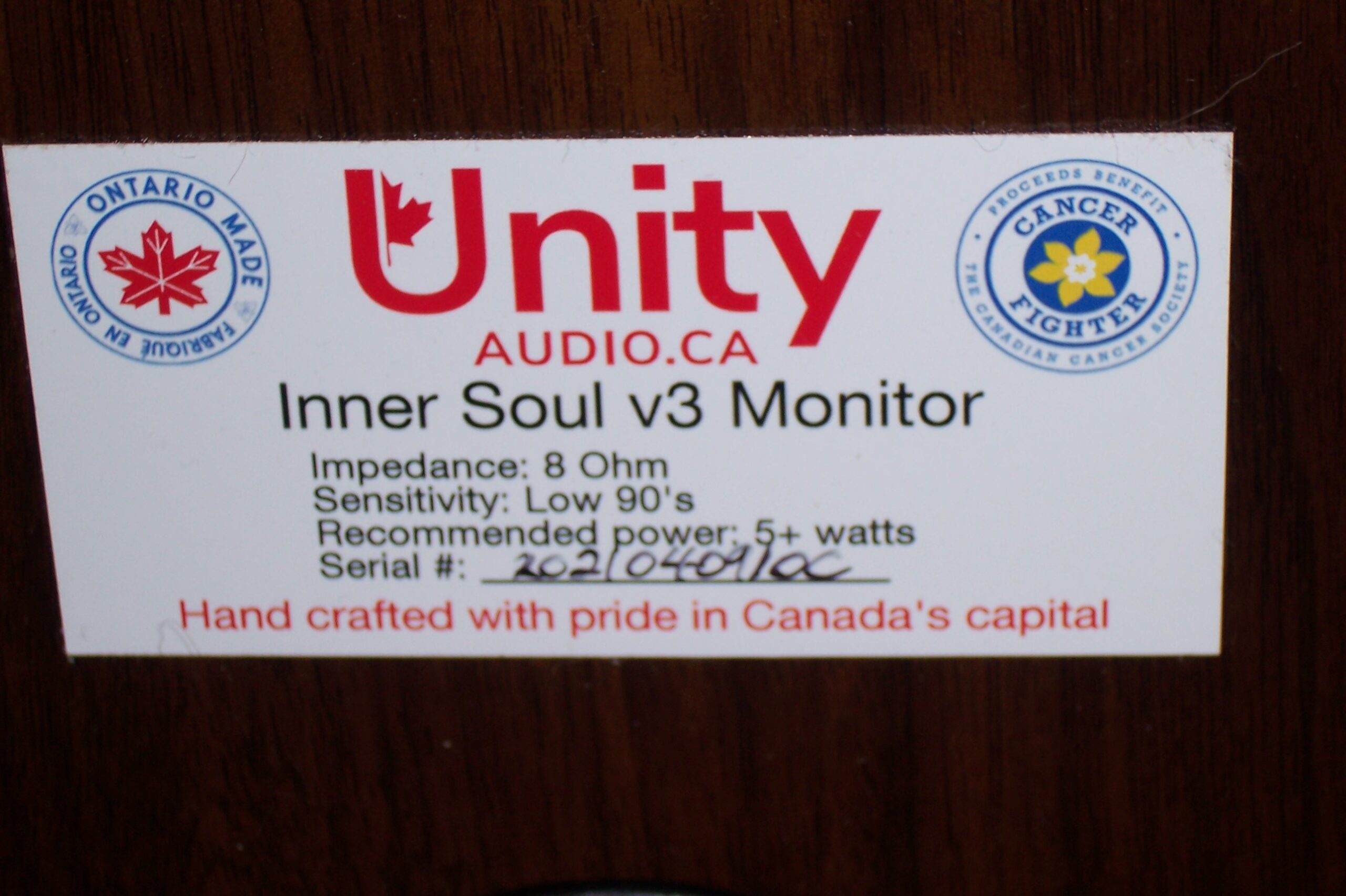
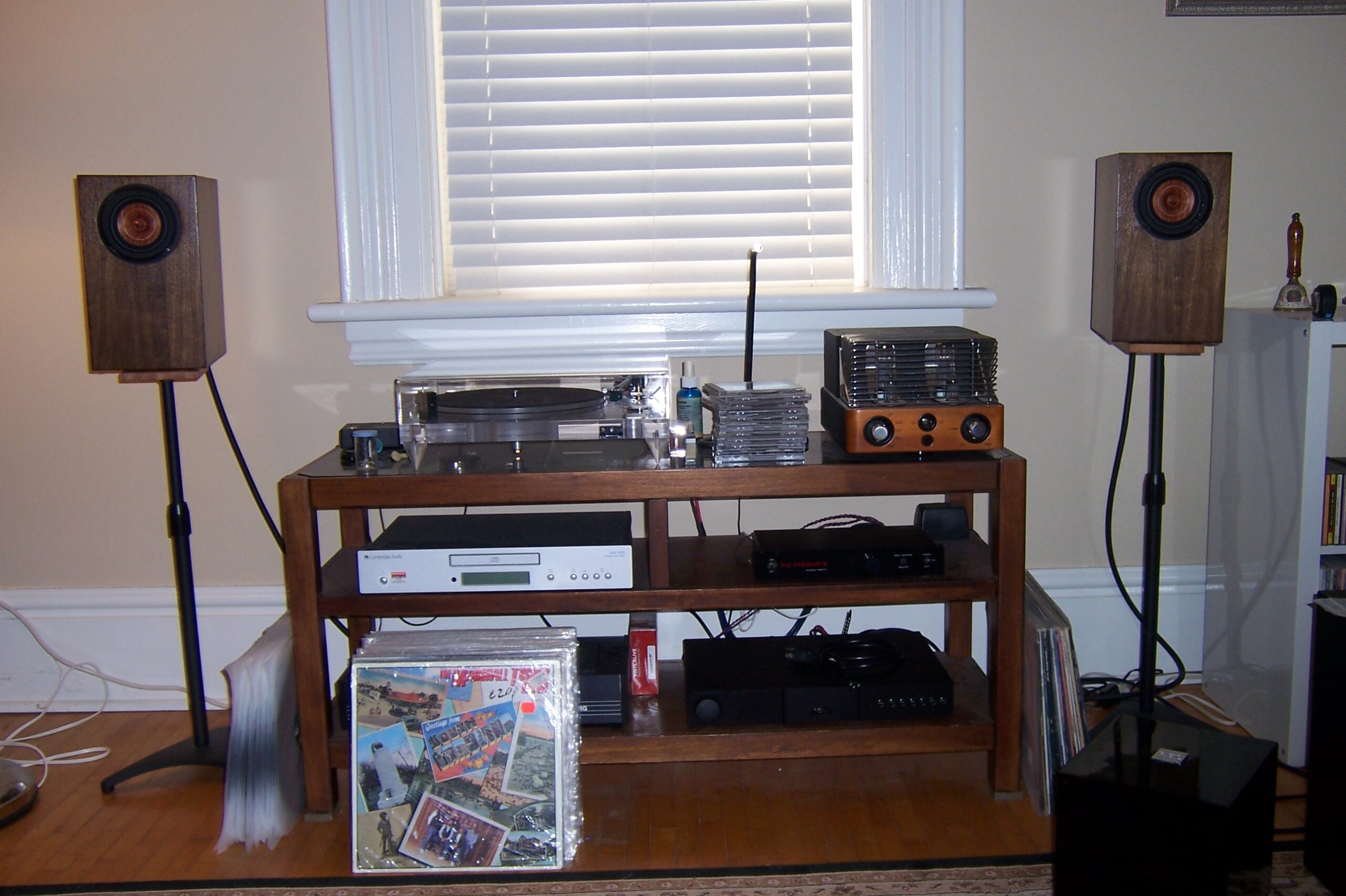
Greetings,
A direct competitor and alternative to the Unity Audio Inner Souls are the American made Omega Loudspeaker Super 3i Monitors.
https://omegaloudspeakers.com/products/super-3i
Super 3 Specifications ; Sensitivity: 94.5 dB at 8 ohms ; Impedance: 8 ohms ; Driver: Proprietary 4.5″ RS5 ; Frequency Response: 55-20kHz $695.00
I’ve owned a pair for about a year and they deliver exceptional sound. Coincidentally, I too pair mine with a REL T/Zero MkIII subwoofer. The Super 3i bookshelves synergize beautifully with my Eastern Electric MiniMax Tube Integrated’s 8 watts. Very high resolution and beautiful tonality are their strong points. The Omega Loudspeakers are essentially a bespoke one man operation. Proprietary drivers and cabinet construction are featured with exceptional finishing of his speakers a hallmark of his speakers. Result; a devoted following among knowledgeable low watt fans.
Geoffrey,
Thanks for your comment. I think most of us even in Canada are more familiar with Omega than Unity. I’ve owned several of the earlier Omegas, and one Unity. Overall the performance is very similar.
Regards,
Noam
Hi Geoffrey,
Thanks for the comment. Noam has experience with the Omega’s and I do not but I think they are working the same territory as the Unity speakers. Nice to see that you paired your Omega’s with the REL T/Zero which is a super fast sub.
Cheers,
David Neice